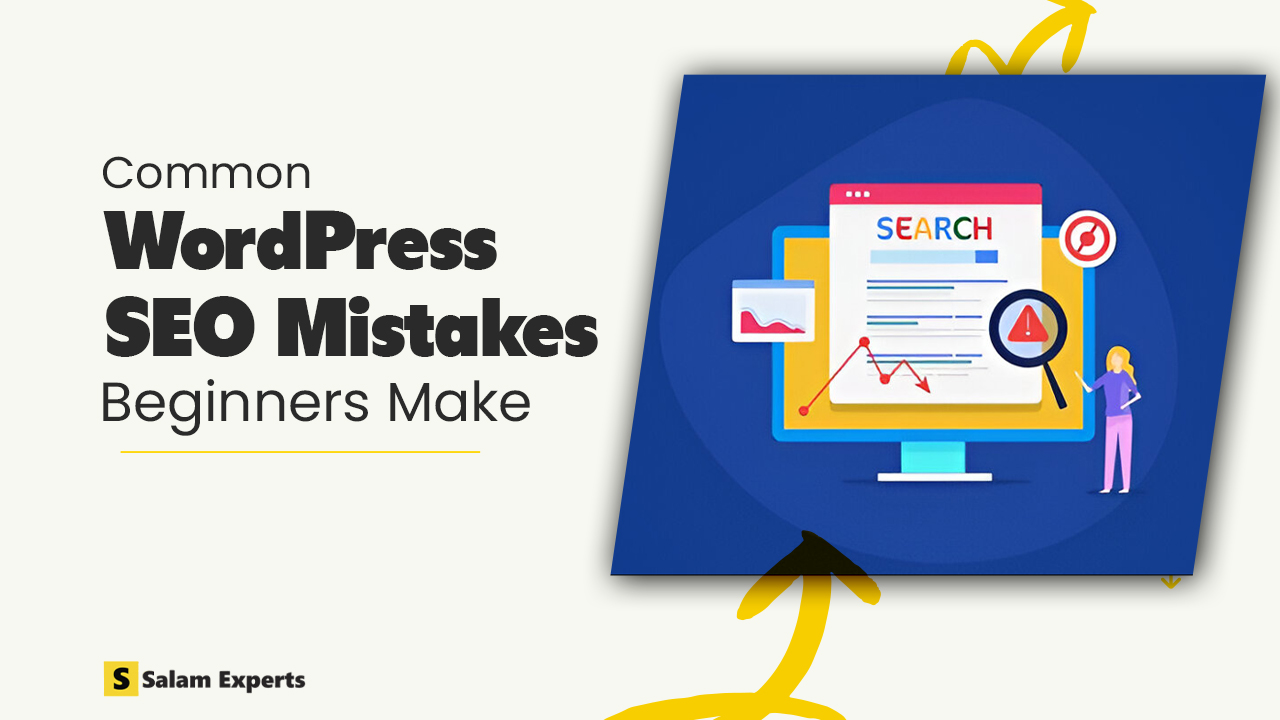🚫 Common WordPress SEO Mistakes Beginners Make (And How to Fix Them)

SEO can be intimidating for beginners, especially when you’re just starting with WordPress. With the right approach, however, you can avoid common SEO mistakes and set your website on the path to success.
In this post, we’ll go through some of the most common WordPress SEO mistakes, and show you how to fix them for better rankings and more organic traffic.
⚡ Mistake #1: Ignoring Title Tags and Meta Descriptions
Your title tags and meta descriptions are among the first things Google looks at to understand what your page is about. Unfortunately, many beginners overlook them.
How to Fix It:
- Make sure title tags are descriptive and include your main keyword.
- Keep title tags between 50-60 characters and meta descriptions under 160 characters.
- Write compelling meta descriptions that encourage users to click through.
Example:
- Title: “How to Optimize WordPress SEO for Beginners”
- Meta Description: “Learn how to boost your WordPress SEO with these beginner-friendly tips and tricks. Improve your search rankings today!”
Ensure you’re following all the best practices for these crucial elements by checking our Essential WordPress SEO Checklist.
⚡ Mistake #2: Not Using Heading Tags Properly (H1, H2, H3)
Heading tags are important for both SEO and user experience. They help search engines understand the structure of your content, and make your content easier to read.
How to Fix It:
- Use one H1 tag per page — usually for the page title.
- Break your content into subsections using H2 and H3 tags.
- Include target keywords in headings where it makes sense.
Example:
- H1: “How to Set Up WordPress SEO”
- H2: “Step 1: Install SEO Plugin”
- H3: “Why Yoast SEO is a Great Choice”
To understand the best way to structure your content with these tags, refer to our detailed guide on Heading Tags SEO Best Practices.
⚡ Mistake #3: Not Installing an SEO Plugin
An SEO plugin can help automate the process of optimizing your website. Without one, you’re missing out on many of the basic on-page SEO optimizations.
How to Fix It:
- Install a SEO plugin like Yoast SEO, Rank Math, or All in One SEO.
- Use the plugin to:
- Optimize meta tags
- Generate an XML sitemap
- Control breadcrumbs
- Implement schema markup
Using an SEO plugin to generate an XML sitemap helps Google find and index your content faster (learn more about this process in our guide on how to index your website fast).
Pro Tip: These plugins also provide an SEO score for your posts, helping you identify areas that need improvement.
⚡ Mistake #4: Not Using Alt Text for Images
Images are a critical part of your content, but they don’t help with SEO unless you add alt text. Alt text helps Google understand the image content and also improves accessibility for users with disabilities.
How to Fix It:
- Add descriptive alt text for every image.
- Use keywords naturally, but don’t overstuff.
- Describe the image’s context or what it represents.
Example:
- Image Alt Text: “WordPress SEO dashboard showing optimization score for a blog post”
For more detailed advice on writing effective alt text, check out our guide on the Best Practices of Alt Text for Images.
⚡ Mistake #5: Slow Page Load Speed
Slow loading times are a huge SEO factor. Google considers page speed a ranking signal, and users are likely to leave if your site takes more than a few seconds to load.
How to Fix It:
- Use a caching plugin like W3 Total Cache or WP Super Cache.
- Compress your images before uploading them.
- Choose fast hosting and enable CDN (Content Delivery Network).
- Minimize the use of heavy scripts and unnecessary plugins.
Example Tools:
- GTmetrix or PageSpeed Insights to test your site speed.
- Smush or Imagify to compress images.
⚡ Mistake #6: Not Using Internal Links
Internal linking helps both search engines and users navigate your website. It also helps spread link equity across your pages.
How to Fix It:
- Link to relevant content within your posts and pages.
- Use descriptive anchor text (avoid “click here”).
- Ensure your most important pages have more internal links pointing to them.
Example:
- “If you want to dive deeper into WordPress plugins, check out our comprehensive guide on essential WordPress plugins for beginners.”
⚡ Mistake #7: Forgetting About Mobile Optimization
With mobile-first indexing, Google prioritizes mobile-friendly websites. If your WordPress site isn’t mobile-friendly, you’ll likely suffer in rankings.
How to Fix It:
- Use a responsive theme that adjusts to different screen sizes.
- Test your site on different devices to ensure it looks good and loads quickly.
- Use Google’s Mobile-Friendly Test tool to identify issues.
⚡ Mistake #8: Not Using Structured Data (Schema Markup)
Structured data helps Google understand the content of your page, and it can increase your chances of appearing in rich results (e.g., star ratings, FAQ snippets).
How to Fix It:
- Use plugins like Yoast SEO or Rank Math to add schema markup to your posts.
- Add FAQ schema, review schema, and product schema where relevant.
Example:
If you run a blog about recipes, use Recipe schema to display your recipes in Google’s rich snippets.
⚡ Mistake #9: Not Updating Old Content
SEO is not a one-time thing. Over time, content can become outdated, and if you don’t refresh it, you could lose rankings.
How to Fix It:
- Regularly update your old blog posts with fresh information.
- Add new internal links to keep the content relevant.
- Update your meta tags and headings for newer keyword trends.
⚡ Mistake #10: Not Tracking Your SEO Efforts
Without tracking, it’s hard to know if your efforts are paying off. You need to monitor traffic, rankings, and engagement to make data-driven decisions.
How to Fix It:
- Set up Google Analytics and Google Search Console.
Track your keyword rankings using tools like Ahrefs or SEMrush.
📈 Final Thoughts
SEO mistakes are common, but with the right fixes, you can quickly turn things around and improve your website’s rankings. By addressing these issues, you’ll set your WordPress site up for long-term SEO success.






